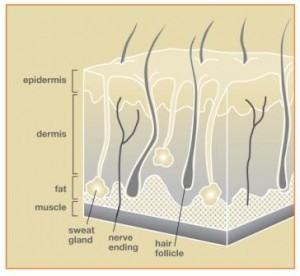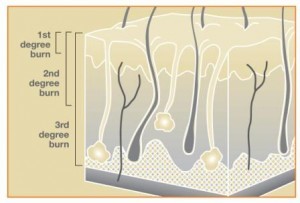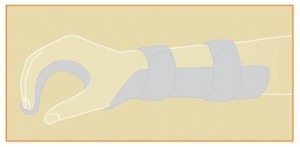What happens in burns?
When the skin comes in contact with something hot, it may be damaged, with death of cells in the skin. The depth of the injury depends on the intensity of the heat and the length of time that it is applied. If sufficiently severe, the full thickness of the skin can be destroyed, as well as tissues under it. Burns can also result from contact with certain chemicals.
What are the degrees of burn injury?
 Figure 1
Figure 1
Burns are classified by the depth of injury, which helps determine the appropriate treatment (see Figure 1-2).
1st Degree: superficial—redness of skin without blisters
2nd Degree: partial thickness skin damage—blisters present
3rd Degree: full thickness skin damage—skin is white and leathery
4th Degree: 3rd degree with damage to deeper structures, like tendons, joints, bone.
What kind of treatment is needed?
 Figure 2
Figure 2
After first aid measures that include removing the hand from the source of heat and keeping it clean, treatment focuses on preventing further problems with stiffness and infection. The treatment depends on the depth and extent of the burn. Burns over a major percentage of the body require hospitalization and care in special burn units. Burns localized to the hand may be treated on an outpatient basis if the pain can be adequately controlled.
1st Degree (Superficial Burns): Treated primarily for comfort with local analgesics and pain medications. These usually heal within a week.
2nd Degree (Partial Thickness Burns): Blisters may or may not be trimmed but the hand and forearm should be splinted in a position of safety to prevent later stiffness. If there are open, raw surfaces, cleaning with frequent dressing changes and the application of local topical antibiotics is performed until the wounds are healed. Wound healing occurs within two to three weeks. Some 2nd degree burns may need excision of damaged skin followed by skin grafting.
 Figure 3
Figure 3
3rd Degree (Full Thickness Burns): The dead skin will need to be removed and replaced with skin grafts. The timing of this depends on the size and location of the burns. Most surgeons remove the dead skin as soon as it is evident that the burn is full thickness, and graft immediately. The hand is then splinted (see Figure 3) until the grafts are healed, and then mobilization begins. Ideally this is within two to three weeks after the injury. Small full thickness burns may be treated like the partial thickness but will take longer to heal and will leave scarring.
A burn that goes around the full circumference of the limb can sometimes constrict it like a tourniquet. In such cases, the constriction may need to be released, a procedure known as escharotomy.
What about therapy and rehabilitation?
The need for therapy depends on the depth of the burn wound and any other factors that may lead to stiffness in the hand. Superficial burns generally will not need any formal hand therapy.Deeper burns or those that occur in conjunction with other injuries may require extensive therapy and rehabilitation. Your hand surgeon will coordinate therapy with a therapist if he or she feels that you would benefit from rehabilitation.
Will additional surgery be necessary?
Many patients with burn injuries will require more than one operation. Many burned hands will develop contractures months or years after the original injury. Long-term follow up with your hand surgeon should be planned to evaluate for the possibility that further surgery may improve your hand function.
Download the Burns PDF
